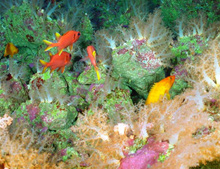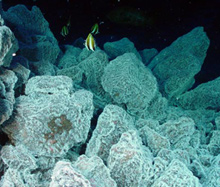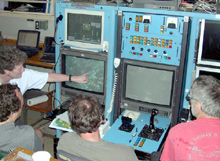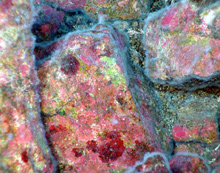
On the summit of East Diamante (170 m, 558 ft depth), all signs of hydrothermal venting have disappeared. Soft corals (~10-15 cm or 4-6 in tall) and tropical fish share the paradise we named "Aquarium." Click image for larger view.
Ecothoughts: Figuring Out Vent Ecosystems on the Fly
April 8, 2004
Kim Juniper
Biologist
University of Quebec, Montreal
![]() The central cone at East Diamante volcano (mp4, 3.9 MB)
The central cone at East Diamante volcano (mp4, 3.9 MB)
![]() The "Aquarium" site at East Diamante volcano (mp4, 5.2 MB)
The "Aquarium" site at East Diamante volcano (mp4, 5.2 MB)
Modern ecology often involves proposing hypotheses based on ecological theory and then making observations and experiments to test them. What do you do if you have no ideas about what you are going to study? How does an ecologist prepare for a cruise like this one, where most of the biological communities we will be exploring with the ROV (remotely operated vehicle) are unknown? You begin with very simple goals, leave room for surprises and figure things out as you go along. Our first question when we dive on a new site is “What’s there?” To answer that question, we sample and identify the organisms that are colonizing the hydrothermal vents. Our second question is “How does the ecosystem work?” To answer that, we must look at which organisms are found where, and which species are found together. With a basic understanding of what’s there, how different groups of organisms feed and how they occupy space, we then begin to understand how food chains are organized (i.e., who eats who) and how different species might be competing for resources.

At East Diamante volcano (195 m, 640 ft depth), tropical fish swim above boulders covered with bacterial mat, which indicates the presence of hydrothermal venting. These fish live in the reef community above and are about 15 cm (6 in) long. Click image for larger view.

Left to right: Verena Tunnicliffe, Kim Juniper, Keith Shepherd and Bob Holland gather around the ROPOS console to identify vent species on the sea floor. Click image for larger view.
This is usually a step-by-step scientific process, but here we are obliged to do everything at once, on the fly, so that we can finish with one volcanic site and get on to the next one. Our cruise itinerary is very ambitious and we have a lot of exciting sites to visit in a short period of time. So, while ROPOS is on the sea floor discovering vents, the ecologists are glued to the screens in the control room, discovering and discussing what species live where, even before we sample them. After a dive, as we are processing and identifying species in the ship’s biology lab, the ecological brainstorming continues. We refine our ideas about how the ecosystem works as we look down microscopes and answer the “What’s there?” question. Before we go on to the next site, we summarize our ideas in a brief document I call "Ecothoughts." This is a way of getting all our brainstorming and observations down on paper before our memories are overloaded by discoveries at the next site. The following "Ecothoughts" paragraph from our dives at East Diamante describes one of the most exciting discoveries so far for the ecologists on the cruise:

At East Diamante volcano (190 m, 623 ft depth), the chemosynthetic and photosynthetic communities overlap. Patches of encrusting red and green algae lie beneath filamentous bacterial mats on rock surfaces. The small white corals on the rocks are about 5 cm (2 in) long. Click image for larger view.
Further upslope on the central cone, seamount fish species were sighted more frequently at vents, and some even appeared to graze on bacterial mats. The 195 m (640 ft) depth contour marked the appearance of perceptible sunlight and the beginning of an extraordinary transition from a chemosynthetic productivity regime to one dominated by photosynthesis. The transition began with the appearance of patches of encrusting red algae on rock surfaces beneath filamentous bacterial mats. Visible shimmering water indicated widespread hydrothermal venting. Further upslope, near 190 m (623 ft), both green and red algae colonized rocks beneath a thinning but still complete coverage by filamentous bacteria. Finally, bacterial filaments and signs of hydrothermal venting disappeared near the summit of the cone at 170 m (558 ft), giving way to a high-density suspension feeder community dominated by soft corals.
Sign up for the Ocean Explorer E-mail Update List.



























